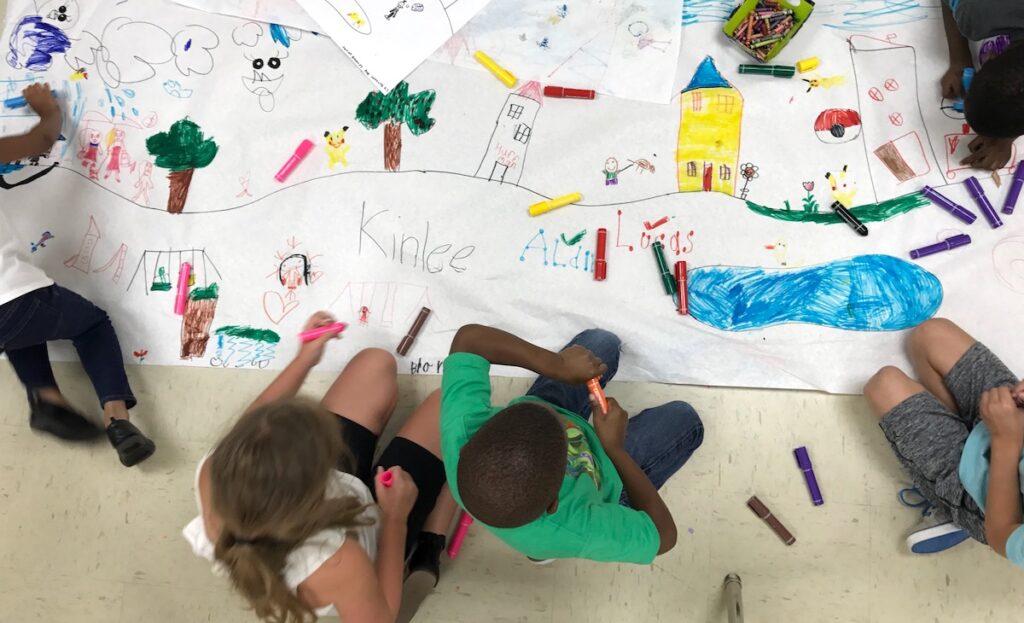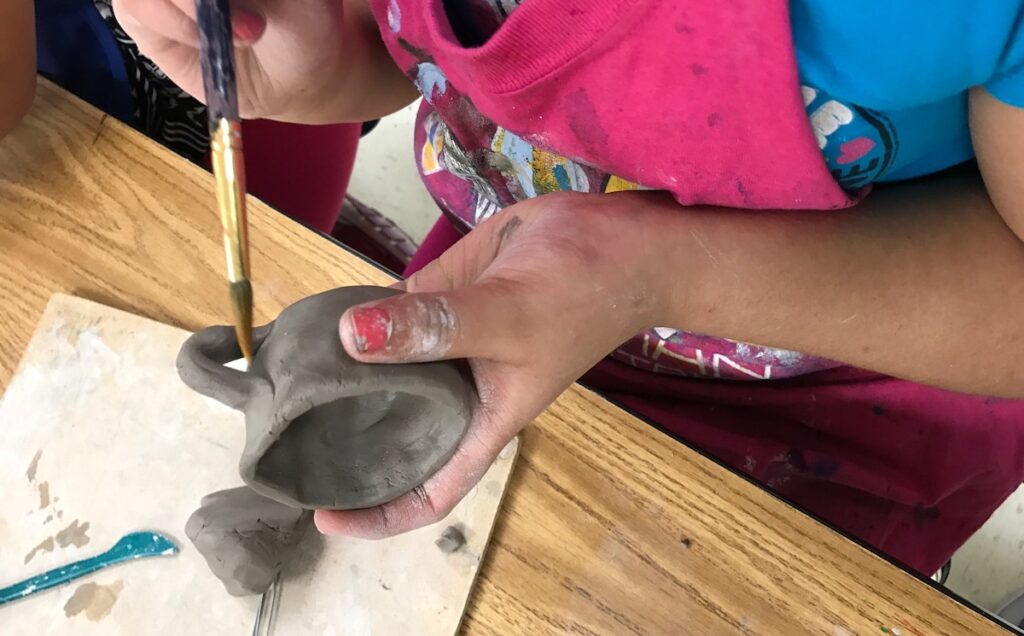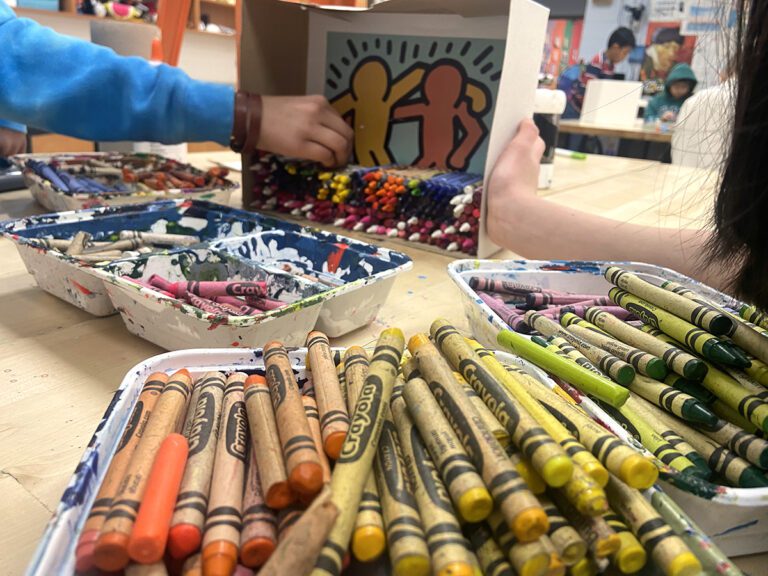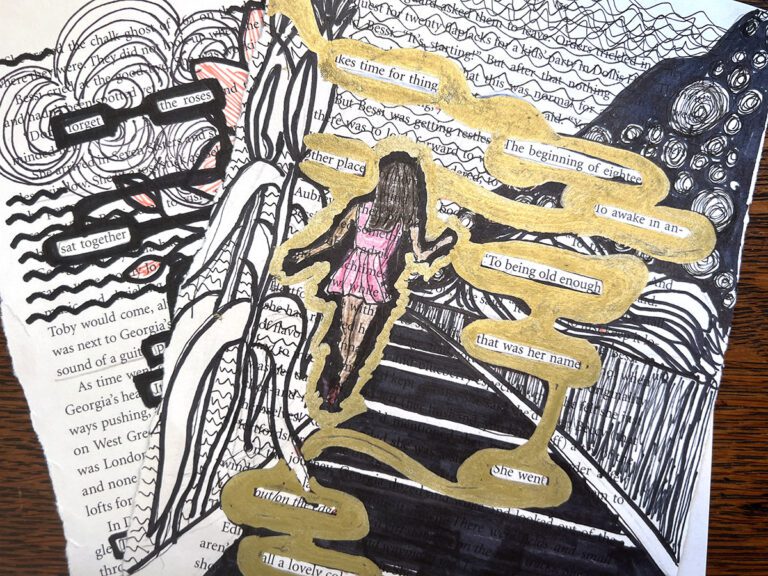Some people, maybe even in our own buildings, view the art room as a chaotic place where kids “just go to color.” But we know nothing could be further from the truth.
We know the art room is one of the places students feel free to express themselves. It’s a place to learn the power of perseverance and build self-esteem through trial and error. It’s a place to collaborate and learn how to work with others.
In short, the art room is a place where students gain a wide array of transferable leadership skills that will help them both in and out of school.
These leadership skills transfer to our students’ everyday lives and future careers. Not every student is destined to be an artist, but art class provides students with important skills that contribute to a well-rounded education. These are skills will be beneficial to them no matter what path in life they choose.
Here are 6 leadership skills students gain through art.

1. Collaboration
Art provides an outlet for students to create work independently but it also lends itself to natural collaboration and collaborative projects. These experiences allow students to learn how to work with others.
One easy way to get students of any age collaborating is to have them work on a large drawing together. I’ve even done this with my kindergarten students! Simply divide students into groups, pass out large pieces of paper, give a simple theme, and let them go!
The last time I did this with my students, I gave locations as a theme. These included: beach, forest, neighborhood, city, etc. Students started with a simple horizon line, brainstormed a bit, and began creating. This is a great way to have students work toward a common goal.
2. Communication
There are many different ways to bring the idea of communication into the art room. In the previous example of a collaborative drawing, students needed to communicate with one another to create a cohesive drawing. Collaboration and communication often go hand-in-hand.
Aside from collaborative projects, artists also need to be able to communicate their ideas orally or through artist statements. These can be ideas about their own work or ideas about the work of others through class critiques.
Being able to collaborate and communicate effectively are definitely skills leaders in society need. They are essential skills in working well with others and maintaining positive work environments. I intentionally share this idea with students so they can make connections from art class to other areas of their lives.

If you’d like to share these ideas with students, download the poster for your classroom below!
3. Creativity
As Henri Matisse once famously said, “Creativity takes courage.” This rings true today. Thinking outside the box and trying new ideas are skills students practice in the art room every day. Leaders need these skills in order to take their teams to the next level and approach problems with a fresh perspective.
The Innovative Teaching, Learning and Leadership Consultant, George Couros, says, “Often the biggest barrier to innovation is our own way of thinking.” Art allows students the opportunity to think in different ways thus building their creative capacity. Learning how to deal with failure and explore a variety of techniques and processes will serve them well in the future.

4. Problem-Solving
Not a day goes by when students aren’t practicing their problem-solving skills in the art room. Of course, there are the creative problems they solve in regards to the assignments, themes, or centers presented to them. But there are also the essential questions that run throughout an art curriculum.
Questions like:
- Why do artists’ create?
- What can an artist do to create texture in their art?
- How can you add movement to your artwork?
Whether students are trying to mix a certain color, build a structure with recyclables to stand on its own, or produce a certain design, they are using problem-solving skills. The leaders of tomorrow will undoubtedly come across countless problems to solve. Our artists will be ready!

5. Commitment & Perseverance
Artwork students create in our classrooms can take anywhere from a single class period to many weeks. The planning process alone can involve brainstorming, sketching, exploring media, and research. It takes perseverance and commitment to begin a project and see it through to completion. This is especially true if a student’s idea morphs and changes as they work through problems.
Leadership positions require individuals to stay committed to their roles and plans, even when problems arise. Leaders must be able to stick with their vision and mission when the going gets tough. Practicing these exact skills in the art room can help set our students up for success.
6. Responsibility
Having a responsible person in a leadership position is important. Students have many opportunities to learn responsibility in the art room.
Here are a 7 ways you can foster responsibility with your students.
- Have your students clean their own paintbrushes.
- Have your students put away their own supplies in the correct places.
- Have your students help you create and uphold the classroom expectations.
- Require your students to follow all classroom procedures.
- Encourage your students to be honest.
- Make sure all students are helping during cleanup time.
- Help your students develop strategies for staying on task during work time.
Make sure you have clear expectations, procedures, and consequences in your art room to help students learn responsibility.
Our students may not all grow up to be CEOs, principals, or managers, but that does not mean they can’t lead others. We can teach our students they can be a positive influence on those around them no matter the position they’re in. Instilling these skills in our students will be essential to their growth as individuals and citizens of their wider communities.
If you’d like to hear even more about Leadership, join me at the Summer 2017 Art Ed Now Online Conference for my talk Art Teachers as Leaders: Promoting Change and Creating Culture. I’ll be talking about why we are on the leading edge of transforming education with our innovative practices. I hope you’ll join me!
What other leadership skills do you believe are fostered through art?
What tasks would you add to the list that make students responsible in the art studio?
Magazine articles and podcasts are opinions of professional education contributors and do not necessarily represent the position of the Art of Education University (AOEU) or its academic offerings. Contributors use terms in the way they are most often talked about in the scope of their educational experiences.






